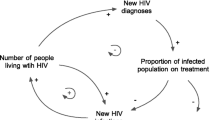Abstract
The prevalence of human immunodeficiency virus (HIV) in correctional facilities is much higher than in the general population. However, HIV prevention resources are limited, making it important to evaluate different prevention programs in prison settings. Our study presents the cost-effectiveness of offering HIV counseling and testing (CT) to soon-to-be-released inmates in US prisons. A decision model was used to estimate the costs and benefits (averted HIV cases) of HIV testing and counseling compared to no CT from a societal perspective. Model parameters were HIV prevalence among otherwise untested inmates (1%); acceptance of CT (50%); risk for HIV transmission from infected individuals (7%); risk of HIV acquisition for uninfected individuals (0.3%); and reduction of risk after counseling for those infected (25%) and uninfected (20%). Marginal costs of testing and counseling per person were used (no fixed costs). If infected, the cost was $78.17; if uninfected, it was $24.63. A life-time treatment cost of $186,900 was used to estimate the benefits of prevented HIV infections. Sensitivity and threshold analysis were done to test the robustness of these parameters. Our baseline model shows that, compared to no CT, offering CT to 10,000 inmates detects 50 new or previously undiagnosed infections and averts 4 future cases of HIV at a cost of $125,000 to prison systems. However, this will save society over $550,000. Increase in HIV prevalence, risk of transmission, or effectiveness of counseling increased societal savings. As prevalence increases, focusing on HIV-infected inmates prevents additional future infections; however, when HIV prevalence is less than 5%, testing and counseling of both infected and uninfected inmates are important for HIV prevention.
Similar content being viewed by others
References
Glaser JB, Greifinger RB. Correctional health care: a public health opportunity.Ann Intern Med. 1993;118(2):139–145.
Vlahov D. HIV-1 infection in the correctional setting.NIDA Res Monogr. 1992;118:51–56.
Altice FL, Mostashari F, Selwyn PA, et al. Predictors of HIV infection among newly sentenced males.Acquir Immune Defic Syndr Hum Retrovirol. 1998;18(5):444–453.
Kamb ML, Fishbein M, Douglas JM, et al. Efficacy of risk-reduction counseling to prevent human immunodeficiency virus and sexually transmitted diseases: a randomized controlled trial.JAMA. 1998;280:1161–1167.
Varghese B, Peterman TA, Holtgrave DR. Cost effectiveness of counseling and testing and partner notification: a decision analysis.AIDS. 1999;13:1745–1751.
Farnham PG, Gorsky RD, Holtgrave DR, et al. Counseling and testing for HIV prevention: costs, effects, and cost-effectiveness of more rapid screening tests.Public Health Rep. 1996;111:44–53.
Varghese B, Branson BM. Cost and cost-effectiveness of oral fluid HIV testing compared to serum testing. In: Program and abstracts of the XIII International AIDS Conference; July 9–14, 2000; Durban, South Africa. Abstract ThPeC5433.
Holtgrave DR, Pinkerton SD. Updates of cost of illness and quality of life estimates for use in economic evaluations of HIV prevention programs.J Acquir Immune Defic Syndr Hum Retrovirol. 1997;16(1):54–62.
Hammett TM, Harmon P, Maruschak LM.1996–1997 Update: HIV/AIDS, STDs, and TB in Correctional Facilities. Issues and Practices, 1999. NCJ 176344. Washington, DC: National Institute of Justice, Centers for Disease Control and Prevention, and Bureau of Justice Statistics; July 1999.
Sweeney PA, Fleming PL, Karon JM, Ward JW. A minimum estimate of the number of living HIV infected persons. In: Program and abstracts of the Interscience Conference on Antimicrobial Agents and Chemotherapy; September 28–October 1, 1997; Toronto, Canada. Abstract I-16.
Hoxie NG, Vergeront JM, Frisby HR, et al. HIV seroprevalence and acceptance of voluntary HIV testing among newly incarcerated male prison inmates in Wisconsin.Am J Public Health. 1990;80:1129–1131.
Behrendt C, Kendig N, Dambita C, et al. Voluntary testing for HIV in a prison population with a high prevalence of HIV.Am J Epidemiol. 1994;139:918–926.
Rutherford GW, Woo JM, Neal DP, et al. Partner notification and the control of human immunodeficiency virus infection.Sex Transm Dis. 1991;18(2):107–110.
Hoffman RE, Spencer NE, Miller LA. Comparison of partner notification at anonymous and confidential HIV test sites in Colorado.J Acquir Immune Defic Syndr Hum Retrovirol. 1995;8(4):406–410.
Toomey KE, Peterman TA, Dicker LW, et al. HIV partner notification: cost and effectiveness data from an attempted randomized controlled trial.Sex Transm Dis. 1998;25:310–316.
Mastro TD, DeVincenzi I. Probabilities of sexual HIV-1 transmission.AIDS, 1996;10:S57-S82.
Hammett T, Gross M, Epstein J.1992 Update: HIV/AIDS in Correctional Facilities, Issues and Practices. Washington DC: US Dept of Justice; 1994.
De Vincenzi I. A longitudinal study of human immunodeficiency virus transmission by heterosexual partners.N Engl J Med. 1994;331(6):341–346.
McKay NL, Phillips KM. An economic evaluation of mandatory premarital testing for HIV.Inquiry. 1991;28:236–248.
Holtgrave DR, Valdiserri RO, Gerber AR, Hinman AR. Human immunodeficiency virus counseling, testing, referral, and partner notification services: a cost-benefit analysis.Arch Intern Med. 1993;153:1225–1230.
Power R, Hartnoll R, David E. Drug injecting, AIDS, and risk behavior: potential for change and intervention strategies.Br J Addict. 1988;83:649–654.
Casadonte PP, DesJarlais DC, Friedman SR, Rotrosen JP. Psychological and behavioral impact among intravenous drug users of learning HIV test results.Int J Addict. 1990; 25:409–426.
Van den Hoek JAR, van Haastrecht HJA, Couhtino RA. Heterosexual behavior of intravenous drug users in Amsterdam: implications for the AIDS epidemic.AIDS. 1990;4:449–453.
Roggenburg L, Sibthorpe B, Tesselaar H, et al. Characteristics of IVDUs who have been HIV tested. Paper presented at: Sixth International Conference on AIDS; June 23, 1990; San Francisco.
Farley T, Carter M, Hadler, J. HIV counseling and testing in methadone programs: effects on treatment compliance. Paper presented at: Sixth International Conference on AIDS; June 23, 1990; San Francisco.
Hellinger FJ. The lifetime cost of treating a person with HIV.JAMA. 1993;270:474–478.
Gable CB, Tierce JC, Simison D, et al. Costs of HIV/AIDS at CD4 counts disease stages based on treatment protocols.J Acquir Immune Defic Syndr Hum Retrovirol. 1996;2:413–420.
Author information
Authors and Affiliations
Corresponding author
Rights and permissions
About this article
Cite this article
Varghese, B., Peterman, T.A. Cost-effectiveness of HIV counseling and testing in US prisons. J Urban Health 78, 304–312 (2001). https://doi.org/10.1093/jurban/78.2.304
Issue Date:
DOI: https://doi.org/10.1093/jurban/78.2.304




